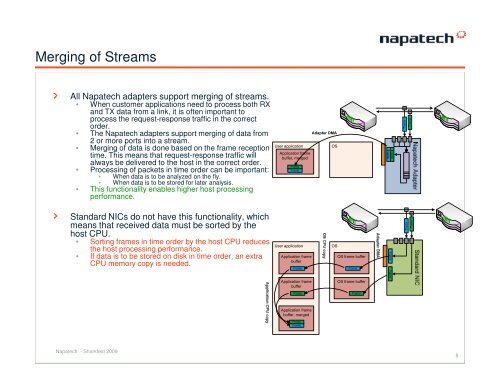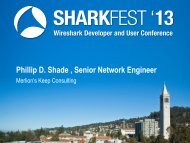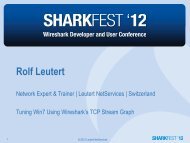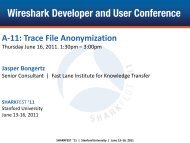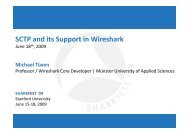Wireshark in a Multi-Core Environment Using Hardware Acceleration
Wireshark in a Multi-Core Environment Using Hardware Acceleration
Wireshark in a Multi-Core Environment Using Hardware Acceleration
You also want an ePaper? Increase the reach of your titles
YUMPU automatically turns print PDFs into web optimized ePapers that Google loves.
Merg<strong>in</strong>g of StreamsAll Napatech adapters support merg<strong>in</strong>g of streams.• When customer applications need to process both RXand TX data from a l<strong>in</strong>k, it is often important toprocess the request-response traffic <strong>in</strong> the correctorder.• The Napatech adapters support merg<strong>in</strong>g of data from2 or more ports <strong>in</strong>to a stream.• Merg<strong>in</strong>g of data is done based on the frame receptiontime. This means that request-response traffic willalways be delivered to the host <strong>in</strong> the correct order.• Process<strong>in</strong>g of packets <strong>in</strong> time order can be important:• When data is to be analyzed on the fly.• When data is to be stored for later analysis.• This functionality enables higher host process<strong>in</strong>gperformance.User applicationApplication framebuffer, mergedFrameFrameAdapter DMAOSStandard NICs do not have this functionality, whichmeans that received data must be sorted by thehost CPU.• Sort<strong>in</strong>g frames <strong>in</strong> time order by the host CPU reducesthe host process<strong>in</strong>g performance.• If data is to be stored on disk <strong>in</strong> time order, an extraCPU memory copy is needed.User applicationApplication framebufferFrameOSOS frame bufferFrameApplication framebufferFrameOS frame bufferFrameApplication framebuffer, mergedFrameFrameNapatech - Sharkfest 20098


